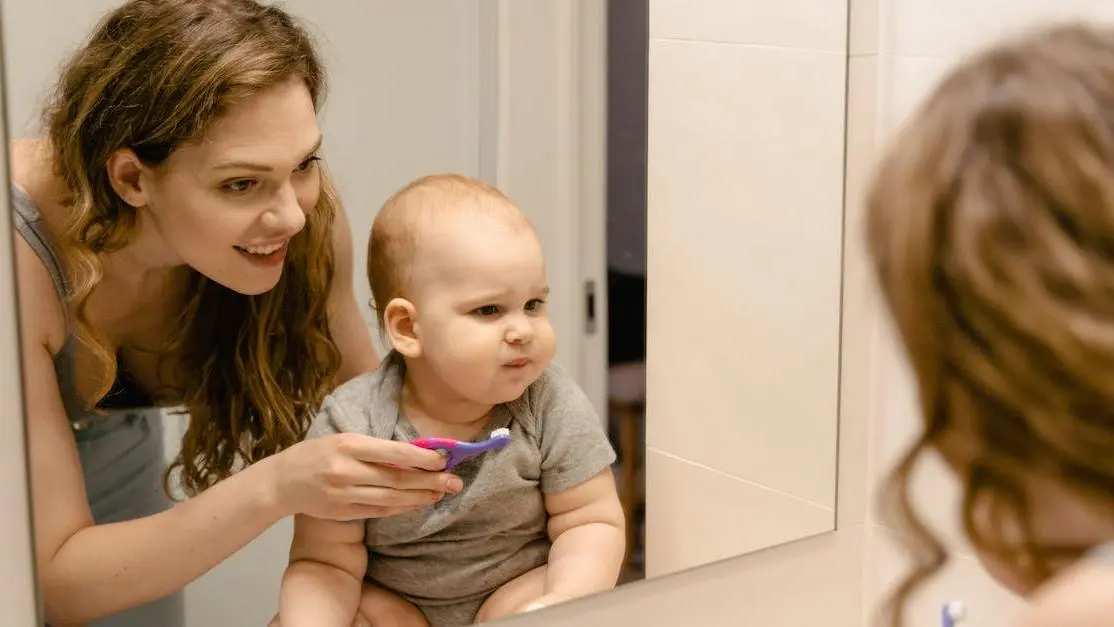New parents in Cookstown and surrounding areas often wonder how to ensure their child's perfect smile from day one.
Our article, "12 Essential Dental Tips for New Parents," tackles just that, providing actionable advice that fosters lifelong oral health for your little one. From early dental check-ups to managing teething, each tip simplifies your journey through key stages of your child's dental care. Start nurturing those tiny teeth today!
Need a more comfortable dental experience? Discover our safe and effective dental sedation and nitrous oxide options.
Need a fun, caring dentist for your child? Explore our kid-friendly kids dentist for a happy dental visit.
1. Start Early with Dental Check-Ups
Prioritizing your child's dental health from the beginning is essential. When that first tooth appears, or by the time they reach their first birthday, it’s time to visit the dentist. Think of this as laying the foundation for lifelong oral health.
Why is early dental care important? Early check-ups help us identify any potential issues and prevent oral problems before they start. You’re ensuring your child gets comfortable with dental visits, which can reduce anxiety later.
Here’s what we suggest for your first visit:
- Choose a Pediatric Dentist: Pediatric specialists create a friendly environment for your little one. This helps them feel at ease, so they can look forward to future visits.
- Schedule Smartly: Try to book appointments when your child is well-rested. Mornings are usually ideal.
- Prepare Your Child: Use storybooks or pretend play to familiarize them with what will happen at the dentist.
Remember, positive first experiences set the tone for their attitude towards dental health.
2. Choose Painless Dentistry for Your Child
Comfort is key in dental visits, especially for children. At Cookstown Dental Centre, we prioritize your child’s comfort and aim to make their experience as pleasant as possible.
How do we achieve this? We use painless dentistry techniques that ease any discomfort. This includes using nitrous oxide, also known as laughing gas, which helps calm nerves without stress. It’s safe and effective, creating a relaxed environment for necessary dental treatments.
- Painless Techniques: We offer options like nitrous oxide that are adapted to meet your child’s specific needs.
- Consultation: Our team discusses these options with you to ensure everyone feels comfortable and informed.
Ultimately, choosing a dental practice focused on minimizing discomfort leads to positive dental experiences and sets the stage for a fear-free future.
3. Teach Proper Brushing Techniques
Oral hygiene begins at home, and teaching your child to brush their teeth properly is a cornerstone of that education. Making brushing fun but effective is a balance that reaps lifelong benefits.
Steps to perfect brushing:
- Start With the Right Tools: Use a toothbrush with soft bristles designed for kids, accompanied by fluoride toothpaste. The size is just right for their little hands and mouths.
- Technique Matters: Encourage small, circular motions. Hold the brush at a 45-degree angle to the gums.
- Set a Timer: Use a 2-minute timer. It’s a game changer for keeping them engaged for the necessary duration.
Engage them with a fun brushing song or reward system to make the experience enjoyable. This not only makes brushing routine but also instills a positive attitude towards personal care.
4. Monitor Sugar Intake
Sugar is a well-known culprit for dental decay. Monitoring your child’s sugar intake from an early age will guard their developing teeth against cavities.
Easy ways to cut down sugar:
- Healthy Alternatives: Opt for tooth-friendly snacks like fresh fruits, veggies, and dairy products. These are less likely to promote decay.
- Set Limits on Sweets: Save sugary treats for special occasions, or perhaps as part of a meal rather than a standalone snack.
- Check Labels: Be vigilant about sugar content in juices and processed foods.
Educating your child on the effects of sugar can change their choices and positively impact their oral health as they grow.
5. Encourage Regular Flossing
Flossing is a crucial step that keeps spaces between teeth clean, enhancing their oral hygiene routine past just brushing. Introducing flossing sooner rather than later makes it a habit they’ll carry forward.
- When to Start: Floss your child’s teeth once they have two teeth that touch, usually around age 2 to 3.
- Use Floss Sticks: These can make the task easier for little hands. They’re designed for kids, simplifying the process.
- Build a Routine: Establish regular flossing alongside brushing to ensure food particles don’t get stuck, which can lead to decay over time.
Taking the time to teach your child how to floss sets a precedent for a thorough oral care routine.
6. Utilize Educational Dental Games
Learning through play is one of the easiest ways to teach children new concepts. Use games to educate your child on dental health, making it both fun and informative.
Ideas for games:
- Pretend Play: Use toys to simulate brushing and flossing. This helps your child visualize and understand the process.
- Interactive Tools: Choose apps or online games that are designed to teach children about healthy dental habits.
The goal is to make dental care engaging to ensure they develop lifelong healthy habits. Turning education into a playful activity makes it more memorable and enjoyable for your child.
7. Prepare Your Child for Dental Visits
Your child’s view of dental visits is shaped largely by how early experiences unfold. Preparing them for what to expect reduces fear significantly.
Tips to smooth the way:
- Positive Portrayal: Explain that the dentist is a friendly helper keeping their smile bright.
- Read About It: Children's books about visiting the dentist can make the experience seem less unfamiliar.
- Role Play: Use a mirror to show how the dentist looks at teeth. This can demystify the process.
Offering reassurance and positive reinforcement after each visit can make future appointments something they look forward to, rather than dread.
8. Address Teething Concerns
Teething can be a challenging time for both you and your baby. Recognizing the signs early and knowing how to ease discomfort can make this phase smoother.
What are typical teething signs? Common symptoms include drooling, a desire to chew on solid objects, and irritability. Your little one might also have swollen or sensitive gums, and it's not uncommon for them to be slightly fussy around feeding times.
How can you help your teething baby?
- Soothing Gums: Gently rub your baby's gums with a clean finger or use a cold washcloth. This offers immediate relief from pressure and pain.
- Teething Rings: Providing a soft, chilled teething ring can help serve as a suitable distraction. This encourages safe chewing and alleviates discomfort.
- Avoid Freezing: While it may be tempting to pop teething toys in the freezer, extremely cold items can hurt your baby's gums. Instead, cooling in the fridge provides the right temperature.
Remember, it's a temporary phase and after those first teeth appear, your diligent care will ensure a healthy, sparkling smile for your child.
9. Manage Pacifier Use
Pacifiers can be lifesavers during those early months, but it's important to manage their use to avoid dental issues. Prolonged pacifier use can lead to problems like misaligned teeth or altered palate shape.
Here are ways to transition smoothly:
- Age Limit: Ideally, aim to wean your child off the pacifier by the age of 2. Beyond this age, the risk of dental misalignments, such as crossbites or open bites, increases.
- Gradual Reduction: Begin by limiting use to nap and bedtime, gradually tapering off as your child becomes more accustomed to other comfort methods.
- Offer Alternatives: Introduce comfort objects like a special blanket or toy to fill the role of emotional support.
Every child is different, and sometimes extra comfort is needed. Work on these transitions patiently and gently to find what your child responds to best.
10. Educate About Hygienic Practices
Good oral habits should start early so they stick for life. By introducing hygienic practices in a way that resonates with your child, you’re setting them up for a lifetime of healthy teeth.
Focus on these strategies:
- Visual Tools: Use brushing charts and colorful stickers to track regular brushing. This makes the routine feel rewarding and visually engaging.
- Fun Tools: Let your child choose their own toothbrush and toothpaste. Bright colors or favorite characters quickly become beloved companions in everyday rituals.
- Interactive Methods: Make up simple songs or rhymes to accompany the brushing task. This makes the activity fun and memorable.
With a little creativity, daily oral care transforms from a chore into a fun and important ritual your child looks forward to.
11. Pay Attention to Gingival Health
While the focus may be on those pearly whites, gum health is equally important. Strong, healthy gums form the foundation for a lifetime of oral health.
Key things to remember:
- Consistent Cleaning: Even before teeth appear, gently wipe your infant’s gums with a soft, moist cloth after feeding to remove any potential bacteria.
- Healthy Diet Choices: Prioritize foods rich in vitamin C and calcium—think citrus fruits and dairy—for strong gums and teeth.
- Watch for Signs: Be on the lookout for red, swollen, or bleeding gums. Early intervention can prevent any large issues in the future.
Establishing these basics early on ensures that your child maintains gum health as an important part of their everyday routine.
12. Replace Toothbrushes Regularly
Replacing toothbrushes is an often overlooked aspect of oral health. Yet, it’s crucial for maintaining optimal hygiene and effectiveness in removing plaque.
Here’s when to replace:
- Every 3 Months: Switching out their toothbrush or toothbrush heads every three months keeps bristles clean and effective.
- After Sickness: Replace your child’s brush after they’ve been sick to avoid reinfection.
- When Bristles Fray: Frayed bristles lose their cleaning effectiveness. Ignoring this leads to missed spots and increased risk of decay.
Encouraging your child to help pick out a new toothbrush as part of this process can turn it into a fun shopping experience.
Understanding Sedation Options for Kids
For children who feel anxious about dental visits, understanding sedation options can significantly improve their experience. It ensures comfort and cooperation, catering to their specific needs.
Types of Sedation:
- Nitrous Oxide (Laughing Gas): This mild sedative helps children relax while staying awake. It wears off quickly, making it an effective choice for minor anxiety during procedures.
- Oral Sedation: A more moderate approach involves administering medicine that keeps children calm yet aware for necessary procedures.
Discuss with our team to find the most suitable option for your child’s specific needs. A calm visit helps reinforce positive attitudes towards dental health.
Conclusion: Set Your Child Up for Dental Success
Ultimately, the journey to perfect oral health begins in these early years. By instilling consistent, positive dental habits now, you set the groundwork for a lifetime of healthy smiles.
Remember, every step you take helps form habits that your child will carry for life. Happy brushing from all of us at Cookstown Dental Centre!
Need a more comfortable dental experience? Discover our safe and effective dental sedation and nitrous oxide options.
Need a fun, caring dentist for your child? Explore our kid-friendly kids dentist for a happy dental visit.

